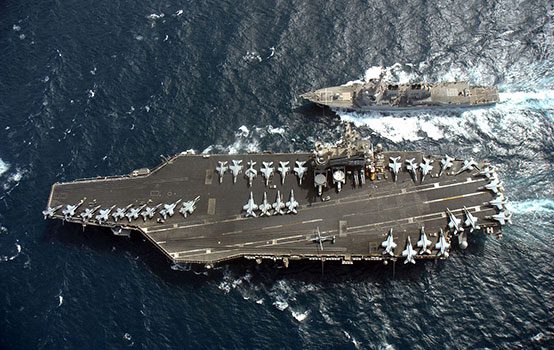The Extravagant Wastefulness of the Iran Obsession

The U.S. is deploying a second aircraft carrier to operate in the Arabian Sea ostensibly to “deter” Iran. This puts an enormous strain on the Navy, it doesn’t appear to have any effect, and it leaves the U.S. shorthanded in other, much more important parts of the world:
But some experts and former senior Navy officials warn there is very little evidence that Iran is deterred by the presence of two carriers. Though they do note there’s ample evidence that the naval deployment draws forces away from operations aimed at deterring China and Russia — something on which the U.S. is supposed to focus per its National Defense Strategy. Furthermore, they told Defense News that the payoff for maintaining two carriers in the region may not be worth the stinging toll it exacts on Navy readiness, adding that pursuing such as strategy will reverse the hard-won readiness gains of recent years.
The deployment of these carriers shows how overcommitted the U.S. is in the Middle East, and it illustrates the irrationality of the Iran obsession. Iran is a medium-sized regional state with limited ability to project power. Dedicating a quarter of all active carriers to “deterring” such a minor threat is an extravagant waste of resources and manpower on an unnecessary mission. Doing this also comes at a cost to naval readiness everywhere else. The Navy had just started to recover from the ill effects of the last time that the U.S. had a two-carrier deployment in the region, and now that will be undone:
During the early 2010s, long deployments and regular surge deployments wore out the ships, aircraft and sailors, creating huge readiness gaps that took years to recover from, Clark said, warning that a return to that posture would have significant consequences.
“The carrier schedules are going to be such that they may not be able to make, or take full advantage of, their maintenance periods,” he said. “And then you’re going to see the kind of cascading effects on carrier readiness that will take years to dig out of.
“Really it has only been in the last nine months that the Navy has managed to shake the lasting effects of that readiness troth.”
Former Navy Secretary Ray Mabus, who presided over the readiness shortfalls created by Mattis’ two-carrier requirement, told Defense News in a March 20 interview that pushing for two carriers now means that down the line those carriers won’t be there when perhaps the need is urgent.
“When Mattis was CENTCOM commander, he demanded [two-]carrier presence and got it, and it messed up the carrier rotations for years [bold mine-DL],” Mabus said. “If you go [with a two-carrier presence] now, you are guaranteeing yourself a gap later on.”
That might be an acceptable risk to take if there were a legitimate reason to devote so many ships to this part of the world, but there isn’t one. Iran is not “deterred” by this, and another carrier just gives the IRGC another target:
“And when they are inside the Persian Gulf, the Iranians perceive them as being an easy target. They can range the entire gulf with shore batteries along the coast in caves and other terrain where it’s hard to root them out,” he added. “So the Iranians see the carrier as a way to get the Americans to spend a lot of money on a show of force that doesn’t really impact their strategic calculation.”
A costly and useless show of force that doesn’t affect Iranian government behavior is exactly what you would expect from the Trump administration’s bankrupt Iran policy.
The article quotes John Glaser, who puts the deployment in the context of the administration’s failed maximalism:
For John Glaser, the director of foreign policy studies at the Cato Institute, the increased carrier presence is a continuation of a failed policy that is less about some vague sense of deterrence and more about compelling Iran to completely fold its cards and bow to U.S. demands.
“If you’re Iran right now, you are incredibly confused as to what the U.S. administration even wants,” Glaser said. “Trump has repeatedly sent the message that he would like to meet face-to-face with Iran’s leaders and hash out a new deal. At other times, he threatens to flatten the country with bombs. Many other principals in his administration are set on regime change.
“And if you take a look at the only specific set of conditions for relief from maximum pressure [as laid out by Secretary of State Mike Pompeo in 2018], what the U.S. is really trying to do is get Iran to capitulate, to forfeit efforts to build defensive weapons and to effectively stop having a foreign policy.”
Ultimately, the failure to achieve a breakthrough is unlikely to be reversed by increased carrier presence, Glaser added.
“Iran’s response to maximum pressure has so far been to rebuild some of its nuclear infrastructure and to lash out with increased violence in the region,” he said. “The tit-for-tat we have seen is Iran reacting to aggressive U.S. policies, and the U.S. not acknowledging the failure of the approach.
“They always say it’s a problem of ‘not enough deterrence.’ ”
The Middle East matters less to U.S. security than ever before and our government needs to be reducing its military footprint in the region instead of looking for excuses to increase it. The Iran obsession is not just reckless and irrational, but it is also compromising U.S. security elsewhere by tying up a large part of our naval forces in useless deployments.
Comments